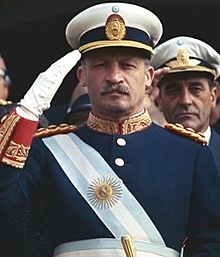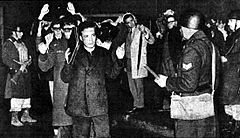Juan Carlos Onganía facts for kids
Quick facts for kids
Juan Carlos Onganía
|
|
|---|---|
 |
|
| 35th President of Argentina Appointed by the military junta |
|
| In office 29 June 1966 – 8 June 1970 |
|
| Preceded by | Arturo Umberto Illia |
| Succeeded by | Roberto M. Levingston |
| Personal details | |
| Born | 17 March 1914 Marcos Paz, Buenos Aires, Argentina |
| Died | 8 June 1995 (aged 81) Buenos Aires, Argentina |
| Political party | none |
| Spouse | María Emilia Green |
| Profession | Military |
| Signature |  |
| Military service | |
| Allegiance | Argentina |
| Branch/service | Argentine Army |
| Years of service | 1934–1970 |
| Rank | Lieutenant General |
Juan Carlos Onganía Carballo (born March 17, 1914 – died June 8, 1995) was a military leader who became President of Argentina. He served from June 29, 1966, to June 8, 1970. He took power by force, overthrowing the elected president Arturo Umberto Illia in a military takeover. This event was called the Revolución Argentina (Argentine Revolution).
Contents
Onganía's Time as President
New Rules for the Country
Before Onganía, military takeovers in Argentina usually set up temporary governments. But the Revolución Argentina led by Onganía wanted to create a completely new way of running the country. This new system was against both democracy (where people vote) and communism. It gave the Armed Forces of Argentina a very strong role in how the country was run, both politically and economically.
In 1963, when Onganía was Chief of the Army, he helped stop a revolt by the Navy. He showed he didn't always follow civilian leaders. He refused to call off his troops even after a ceasefire was agreed upon by the president.
Changes to Economy and Society
As a military leader, Onganía stopped political parties from operating. He also ended the right to strike for workers. He wanted different groups, like businesses and workers, to advise the government. However, he mostly chose these advisors himself.
His Minister of Economy, Adálbert Krieger Vasena, made big changes. He froze wages (meaning salaries couldn't go up) even though prices were rising fast. He also made the Argentine currency worth less. These changes hurt the Argentine economy, especially farming, and helped foreign businesses more.
Culture and Education Under Onganía

Onganía's rule ended the freedom of universities. This freedom had been gained many years before.
Just a month after he took power, Onganía ordered police to invade the Faculty of Sciences at the University of Buenos Aires. This event is known as La Noche de los Bastones Largos (The Night of the Long Police Batons). Students and professors were beaten and arrested. Many were forced to leave the country. This caused a "brain drain," where many smart people left Argentina.
Onganía also tried to stop anything he saw as "immoral." He banned miniskirts and long hair for boys. He also stopped new and modern art movements. These strict rules made many middle-class people, especially those in universities, become more rebellious. In 1969, Onganía officially dedicated Argentina to the Immaculate Heart of Mary.
Protests and His Removal
Over time, other military leaders disagreed with Onganía. They felt their own power was shrinking. In May 1968, rumors spread that another military takeover might happen.
Onganía's strict government also faced many protests from ordinary people. Workers and students across the country protested, especially in cities like Córdoba in 1969 (known as the "El Cordobazo") and Rosario (the Rosariazo).
Finally, a powerful group of military leaders, led by General Lanusse, demanded that Onganía step down. When he refused, they removed him from power.
See also
 In Spanish: Juan Carlos Onganía para niños
In Spanish: Juan Carlos Onganía para niños

